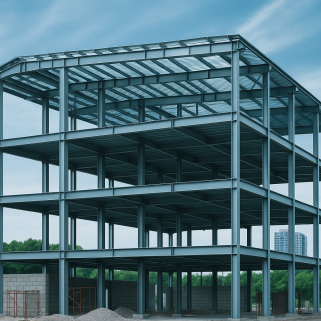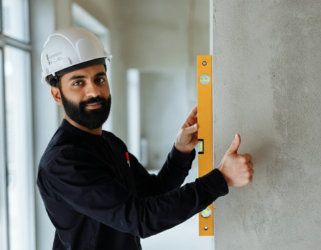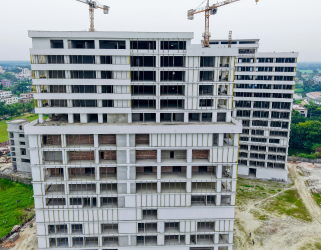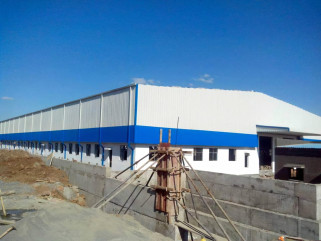Best Pre-Engineered Steel Building Manufacturer in Bareilly | Metrosh

Pre-engineered steel buildings (PEBs) are structures made of steel which are transported to one place before construction and assembled at one place in the factory. Then these pre-engineered steel buildings are designed very beautifully to meet the requirements as per the demand of the people which provide cost effective and safe solutions for different construction needs.
Here are some important points to note as pre-engineered steel buildings are completely customizable:-
Design and Engineering
Pre-engineered steel buildings are designed and engineered using computer-aided design (CAD) software, resulting in superior construction results
Loading Requirement -: Taking into consideration live load, dead load, wind load, and all loading conditions for any building.
Customization -: If you have any special requirements, customize the structure according to its design. well-built to suit your needs.
Design configuration: In design configuration, we look at the shape and size of the building so that we can determine the shape and size of the building as per your demand and also determine its bay spacing which affects the stability and usability of the building and design the clear span keeping in mind the requirement of open spaces inside.
Proper selection of material -The steel grade should be of the best quality that can meet the building requirement, and the coatings and protection should be of good quality coating and painting to avoid rust and other external elements.
Pre-Engineered Buildings (PEBs) vs. Traditional RCC Buildings
| Feature | Pre-Engineered Steel Buildings (PEBs) | Traditional RCC Buildings |
| Construction Time | Significantly faster (up to 50% less time) | Time-consuming (due to on-site processes) |
| Cost Efficiency | Lower due to mass production & minimal waste | Higher due to labor and raw material costs |
| Design Flexibility | Highly flexible & customizable | Limited design flexibility |
| Durability | High; corrosion-resistant if treated properly | Durable but can degrade without maintenance |
| Material Waste | Minimal due to factory fabrication | High due to on-site cutting & adjustments |
| Maintenance | Low maintenance (with galvanizing/coating) | Higher maintenance over time |
| Expansion Capability | Easy to expand or modify | Difficult & expensive to alter |
| Load-Bearing Capacity | Excellent for large spans & heavy loads | Requires more columns; less efficient spans |
| Environmental Impact | Sustainable; recyclable steel components | Higher carbon footprint |
Components of Pre-engineered steel buildings:
The main components of pre-engineered steel buildings are as follows –
Primary Frame – Columns are the main vertical structures that bear the weight of the building. Rafters are horizontal or slatted beams that support the roof. End Wall Frames – Frames located at both ends of a building that provide overall stability to the building.
Secondary Frame -: Purlins are the horizontal beams that support the roof. Girders act as horizontal beams to support the vertical walls. Braces provide great stability and strength to the walls and roof.
Cladding System -: Roof sheeting is the sheet used to cover the entire roof, usually made of galvanized steel or aluminum. Wall sheeting is the sheet used to cover the walls.
Connection -: Bolted connection. The best quality bolts are used to connect different components of any building. Bolted connection components should be joined by welding.
Manufacturing of Pre-engineered steel buildings:
Once the design is finalized, the components are then manufactured precisely in a factory environment to produce the best, consistent settings. Pre – engineered steel building should first make a plan as to how the work will be done, there are many steps in this too which we should follow, by following the rules work is done at a faster pace and work is done in efficient and cost effective manner, here main steps have been given for Pre – engineered steel building.
Assessing requirements and making a plan -: First of all listen to the client and understand his requirements. Then conduct a survey and properly inspect the land where the work is going on and assess its condition.
Design and Engineering -: An engineer’s drawings are structural, architectural drawings and he has to prepare the plan for construction, so the loading requirement is analyzed for different types of loads like live load, dead load, wind load and also using software tools.
Procurement of construction material -: Selecting good steel, such as factory built components like columns, rafters, purlins and other components. Also taking care of coating and protection so that the best coating and painting is done to protect against rust and other external factors.
Maintenance and Support-: Maintenance Guidelines Providing maintenance guidelines for the long term durability and functionality of the building. Support Services: Providing support services for any problems or required maintenance.
Transportation of Pre-Engineered Steel Buildings -:
After the construction of any building, the components are sent to the factory for assembly and construction. It is essential to do the transportation process of Pre-Engineered Steel Buildings properly so that all the components reach the factory safely and on time.
Assembly of Pre-Engineered Steel Buildings -:
The assembly process of pre-engineered steel buildings is designed in a very simple manner. These components are kept ready in advance so that when the building is to be constructed, there is an easy assembly facility at the place.
Versatility of Pre-Engineered Steel Buildings -:
Their wide popularity in different businesses and applications reflects their flexibility and customization, allowing them to be used in a variety of businesses such as industrial buildings, commercial buildings, agricultural buildings, educational and institutional buildings, public utility buildings, etc.
Maintenance of Pre-Engineered Steel Buildings:
Pre-engineered steel buildings are easy to maintain and less expensive than other types of buildings but retain their beauty for a long time. It should be inspected regularly, special care should be taken for cleaning and painting, keep checking the joints and connections, maintain the roofing system, maintain the doors and windows etc.
When it comes to pre-engineered, there are a few things to keep in mind
Customization -When it comes to pre-engineered steel building projects, a good level of customization should be provided to meet certain requirements, and this includes color, design, wall panels, etc.
Clear Span Design
Pre-engineered steel clear span design is a type of construction design that covers wide, continuous spans without any intermediate supports. This design is used in pre-engineered steel buildings (PEBs) to meet the need for large open spaces. It is particularly suitable for applications where the movement of large objects, equipment, or vehicles is required.
Expansion and Modification -:
Pre-engineered steel buildings are very popular these days. People have become very demanding. In today’s time, everything has become modular, cheap, and beautiful
Earthquake Resistant-:
Pre-engineered steel buildings are very good for earthquakes. They have flexibility which makes them an ideal choice in earthquake prone areas. They help dissipate energy during an earthquake.
Fire resistance:
Good quality steel provides fire resistance, which helps in meeting the requirements of the buildings and also provides safety to the occupants.
Energy Efficiency -:
Pre-engineered steel buildings are designed with efficient features such as insulation and reflective roofs to reduce energy consumption.
Pre-Engineered Steel Quality Control-:
Quality control is a crucial aspect of pre-engineered steel buildings (PEBs), ensuring that the structure is safe, durable, and conforms to high standards. The quality control process involves various stages, including design, manufacturing, and installation.
Pre-Engineered Steel Buildings (PEB) is a modern construction technique that offers many advantages over traditional construction methods. In this process, various steel components are manufactured and assembled in the factory according to a pre-determined design, which brings many advantages to us.
FAQs
1. How long does it take to construct a Pre‑Engineered Building (PEB)?
PEBs are known for their speed: factory-fabricated components arrive onsite ready for assembly, dramatically cutting down on time. In India, PEB projects typically finish at least 50% faster than traditional RCC structures—often within a few weeks after design approval
2. What are the maintenance requirements for PEBs?
PEBs are built with high-quality coatings and durable steel, minimizing upkeep. However, key routine steps include:
Annual inspections for structural integrity, fasteners, and seals.
Cleaning exterior surfaces yearly to prevent corrosion from dirt and moisture.
Touching up metal scratches with matching paint to protect exposed areas.
Checking insulation for damage to prevent energy loss and internal corrosion.
Clearing gutters and downspouts—especially before monsoon season.
These basic practices ensure PEBs remain low-maintenance and long-lasting.
3. Are Pre‑Engineered Buildings suitable for residential projects?
Absolutely. Though traditionally used for industrial or commercial spaces, modern PEBs offer great flexibility for residential use. They support architectural finishes like brick facades, glazing, mezzanines, and more. Their large clear spans and modular design make them adaptable and attractive for residences or multi-use buildings.
4. Are PEBs more cost-effective than RCC buildings?
Yes—on multiple fronts:
Construction cost: Optimized design and factory production reduce material waste and labor costs.
Time savings: Faster completion means quicker occupancy and revenue start.
Maintenance: Durable steel and coatings lead to lower long-term upkeep.
Overall, PEBs offer a more budget-friendly and efficient alternative to traditional RCC structures.
5. How durable are Pre‑Engineered Steel Buildings?
PEBs are engineered for resilience and longevity:
Designed to withstand high loads, seismic activity, and harsh weather .
Factory-controlled manufacturing ensures high precision and quality .
Featuring corrosion-resistant coatings and engineer-tested frames, many PEBs remain fully functional for 50+ years with proper maintenance.
Related Articles

Why Pre-Engineered Buildings Are the Ultimate Cost-Saving Solution?
24 Sep 2025
Strong, Durable, and Long-Lasting: The Structural Superiority of PEBs
23 Sep 2025
Quality Control in Civil Construction: Metrosh Infra’s Standards and Practices
22 Sep 2025
Cost-Efficiency in Hybrid Construction: Balancing Budget and Quality
22 Sep 2025
Building the Future: Metrosh Infra’s Approach to Turnkey Civil Construction
20 Sep 2025


